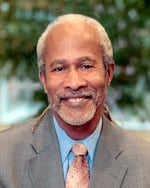
Interstate 5 runs through what was once a thriving Black community in Northeast Portland.
Kristyna Wentz-Graff / OPB
Earlier this month, President Joe Biden released a massive infrastructure spending plan that includes a racial justice element — $20 billion for a program that would “reconnect neighborhoods cut off by historic investments.”
Portland’s Albina neighborhood comes to mind. That’s the historically Black community in inner North and Northeast Portland that was obliterated by the building of Interstate 5 and the Memorial Coliseum in the 1950s and ’60s.

Mike Alexander, a member of the board of directors for the Albina Vision Trust.
Courtesy of Albina Vision Trust
Mike Alexander, a board member with Albina Vision Trust, says the neighborhood was a vibrant, energetic community before the bulldozers came.
“It was the area where many African Americans were told they had the only opportunity for home ownership and business development,” he said. “They created a space that was uniquely reflective of their culture, of their dreams, of their joys.”
An infusion of federal dollars would help advocates realize their vision for a new, revitalized community. Alexander spoke about that with OPB Morning Edition host Geoff Norcross.
Geoff Norcross: Can you first talk about what AVT is envisioning for this neighborhood?
Mike Alexander: AVT is looking to create a space and a place that is reflective of what we aspire to as a city and as a region in terms of equity and inclusion, but also one that builds upon the history of the Albina community. This is a community that has been devastated over the course of decades, at the expense of transportation policies and other institutional uses that have displaced hundreds of families.
Norcross: Neither of us was here before the highway and the coliseum came in, but can you talk to me about what Albina was like before these projects were built?
Alexander: Albina was a total community. It was the area where many African Americans were told they had the only opportunity for home ownership and business development. The community here did what African Americans have done in communities around the country: They created a space that was uniquely reflective of their culture, of their dreams, of their joys, of their businesses and families. And it was an absolute artistic and energetic hub for the city.

The heart of the Albina district, the corner of North Williams and North Russell, was once the center of a small yet thriving business district. This circa 1962 image shows the area before these businesses were torn down in the early 1970s as part of large-scale urban renewal projects.
Courtesy of The Oregon Historical Society (#bb009732)
Norcross: City leaders, when they were trying to justify these projects, declared the area as “blighted.” It doesn’t sound blighted to me.
Alexander: No. The applications, quite frankly, frequently cited that this was an area that was home to the vast majority of African Americans within the greater Portland area, as if that was an indicator of why any other use for this area would have been more, you know, productive.
Norcross: The state is working through a plan to expand I-5 through the area that we’re talking about. And part of that plan would be to cap the freeway so that buildings can be put there and create a continuous neighborhood again. Is Albina Vision satisfied with what they’re proposing?
Alexander: I think conceptually we certainly support the capping of the highway and the creation of programmable land. We are concerned with the scope of that proposal under the current project. It is simply not adequate enough to support the opportunity for expansion and re-stitching a community that had been torn apart by these projects. We are not looking at the development of small remnants of capping. We really want to see the opportunity to build businesses and homes and highways and transportation systems that will support the creation of a total and comprehensive community.
Norcross: We’re having this conversation amidst a great reckoning in America about racial injustices, and I’m wondering what it tells you that our federal government is even thinking about this now — is applying that lens to past infrastructure projects and how they hurt people.
Alexander: I think, for me, it is a source of encouragement and it’s one that I will say can be advanced, not only by communities of color, but communities of conscience. We are fortunate to now have at the helm leadership within the beltway that is as focused on what they can do as much as what they have to do. And I’m hoping that this wave of enlightenment will also lift some of the perspectives that are challenging us here in Oregon.
Click on the audio player at the top of this story to listen to the whole conversation.
